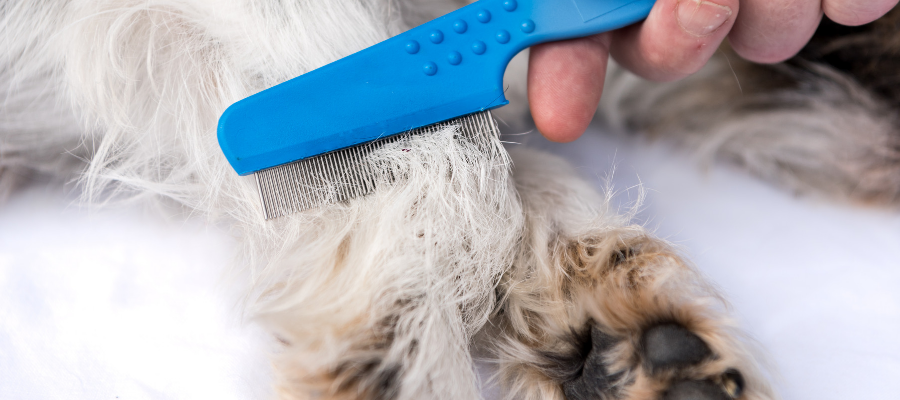Fleas
A flea is small, dark brown, flattened from side to side and has the ability to jump huge distances. This means that only a few moments of contact with an infested animal can lead to problems for you and your pet. Flea bites are not only irritating to your pet but can lead to more serious conditions such as skin inflammation and infection and possible allergic reactions to the fleas themselves. Fleas can also transmit tapeworms as a secondary host.
How do I know if my pet has fleas?
The obvious sign will be itching, usually around the base of the tail, lower back and hind legs. There may also be patches of fur loss or inflammation caused by constant scratching.
Grooming your pet is a good way to spot an infestation; fleas may be difficult to spot in your pet’s fur, but the droppings are easy to find – small black specks containing semi-digested blood. Combing or parting of the fur will reveal the gritty droppings which, when dropped onto damp white paper, leave a characteristic red halo as blood leaches out.
How do I treat and prevent a flea infestation?
Treating your home
As fleas, eggs and larvae are easily transferred from room to room on footwear and clothing, it is necessary to treat the whole house, not just those areas to which pets are allowed access. If your pets travel by car, this will also need treatment. Following directions carefully, treat the area using a spray designed specifically for household use. Then thoroughly clean each room using the fine nozzle of a vacuum cleaner and paying special attention to the edges of fitted carpets, beneath rugs, pet bedding, upholstery and any warm, dark places. Remove the contents of the dust bag from the house.
Treating your pet
Many different types of products are available to control fleas, speak to your vet about which is best to fully protect your pet from parasites. Always follow instructions carefully though, as using too often, or too soon between treatments may lead to the build up of toxic levels of chemicals that could harm your pet. All pets in the household will need to be treated if there is an infestation, although the best thing to do is keep them all up to date on the preventative treatments throughout the year to reduce the chance the fleas have to get into the household in the first place.
Ticks
Ticks are blood sucking insects which live on ground covered with bushes, shrubs or long grass. From there they can easily transfer to passing hosts, such as sheep, deer, cats and dogs.
How do I know if my pet has a tick?
Female ticks are usually big enough to be visible; they may look like brown or red lumps on your pet’s skin. They are most commonly found on the head, neck, groin, armpits and paws. Ticks can also get into the ears so if your pet is shaking their head then it is a good idea to take a closer look. Male ticks are much smaller and you would have to comb through their fur and examine them quite closely to be able to see them.
Why are ticks harmful?
Ticks are second only to mosquitoes in the spread of infectious diseases such as Lyme disease, Babeiosis and Ehrlichiosis. Repeated tick attacks can also cause anaemia. Currently, only Lyme disease is seen in the UK (with the exception of the small outbreak of Babesiosis in Essex). All pets should have tick prevention as the UK is not tick free, but tick borne diseases are very common on the continent so measures should be put into place for tick prevention before travelling.
How do I remove a tick?
Never pull, squeeze or crush a tick as this can leave behind parts of the insect and increases the risk of infection. Pick up a special ‘tick twister’ tool from your vet who will happily show you how to correctly twist the tick out cleanly and safely. If you’re not confident in removing the tick at home, book an appointment with one of our vet nurses to do it for you. If you’re worried about any tick bite, don’t hesitate to contact your vet for advice.
How do I prevent ticks?
Ideally during tick season (from March to September) your pet will be using a product which repels ticks, meaning the chance of your pet getting bitten and a tick latching on is reduced significantly. Your vet can advise you on the best tick protection for you pet.
Lice
Lice are small insects that feed by chewing on the skin or sucking on the blood of an affected pet. They can result in scratching, skin irritation and hair loss and will need to be treated with medicated shampoo or powder. Some flea prevention treatments will also protect against lice, speak to your vet about the best parasite protection for your pet.
Mites
There are many different types of species-specific mites which spend their entire life cycle on the host. The parasite preventing spot-on treatments we offer at Heathfield Vets cover many of the most common mites.
Mange is the general term given to skin disease caused by several different types of mites, but a specific diagnosis is often difficult, requiring multiple skin scrapings as some mites hide in the deeper layers of the skin. Treatment will vary according to the type of mite present, and may have to be continued for prolonged periods. In this area we commonly see sarcoptic or fox mange, which causes severe and constant irritation.
Apart from those causing mange, three other types of mites are easily recognisable.
Ear Mites
Ear mites are very small and rarely seen. They live within the ear canals of the cat or dog, causing intense irritation and scratching. Dogs seem to have a lower tolerance than cats, therefore any cats living in close contact with an infested dog should also be carefully examined. Treatment generally involves removing the loose, crumbly dark brown ear wax which is indicative of ear mites and administering medicated ear drops.
Cheyletiella mites (walking dandruff)
These small white mites live on the skin surface of pets and humans, causing skin irritation and a thick white scruff known as ‘walking dandruff’. Cheyletiella mites are treated with an insecticidal powder or shampoo.
Harvest Mites
Harvest mites are tiny, bright orange insects that can be a problem in late summer and autumn. They are generally spotted at the base of the tail or between the toes and can cause severe irritation and skin inflammation. Special prays and shampoos can be used to treat and prevent an infestation.
To give your pet the best preventative care and protect them from all these nasty creepy crawlies, speak to your vet so they can prescribe suitable parasite control for your pets.
Call us on 01435 864422 if you have any questions about parasite prevention for your pet.


